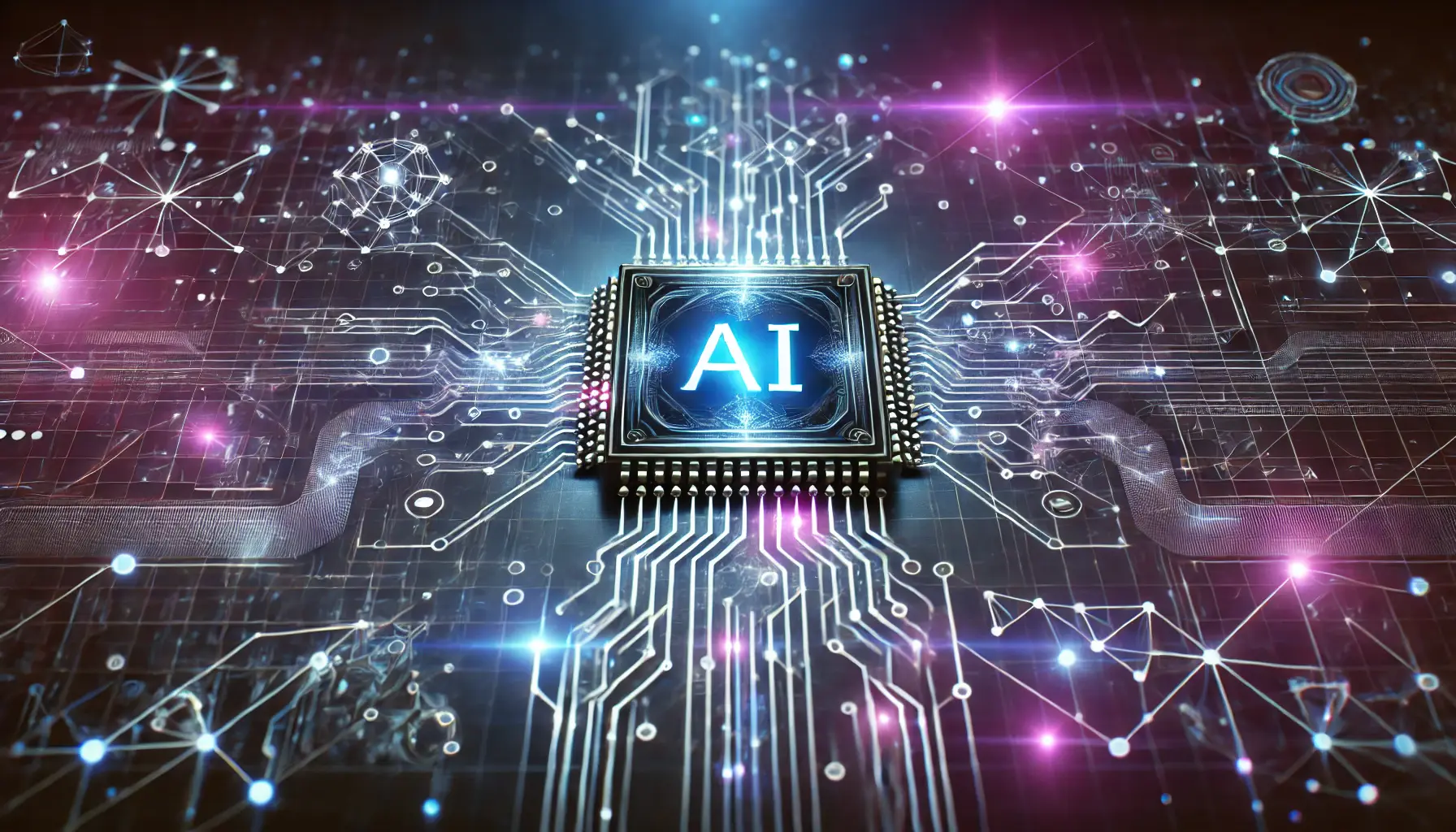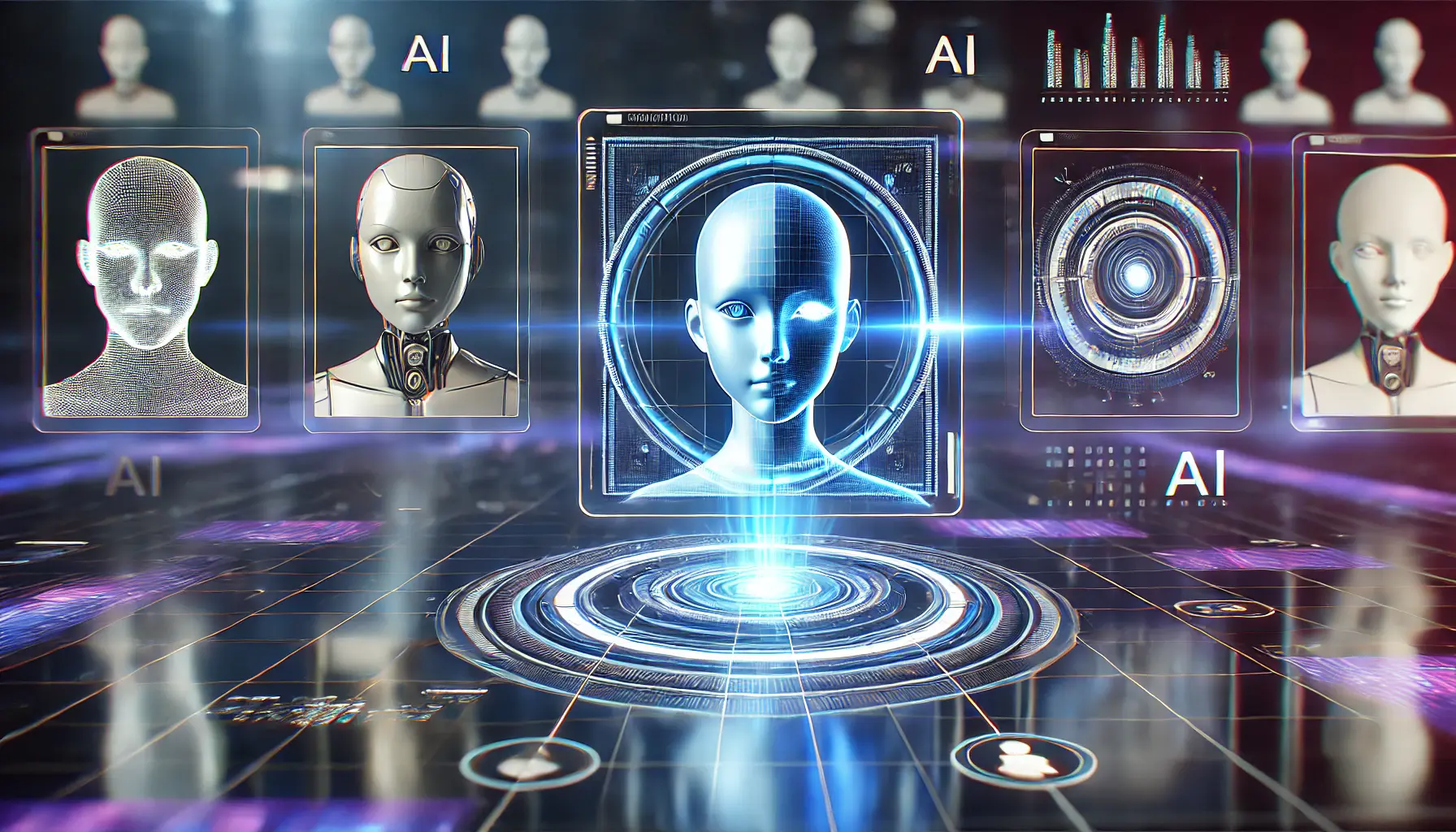In the rapidly evolving landscape of artificial intelligence, staying informed about the latest advancements is crucial.
One such development that has garnered significant attention is DeepSeek R1.
This article delves into the emergence of DeepSeek R1, exploring its background and the key features that set it apart in the AI domain.
- Introduction to DeepSeek R1 and Its Emergence in AI
- Performance Comparison: DeepSeek R1 vs. Leading AI Models
- Open-Source Impact: DeepSeek R1’s Influence on the AI Community
- Challenges and Limitations of DeepSeek R1
- Future Prospects and Developments for DeepSeek R1
- The Evolution and Future of DeepSeek R1
- DeepSeek R1: Frequently Asked Questions
Introduction to DeepSeek R1 and Its Emergence in AI
DeepSeek R1 has recently made waves in the AI community, positioning itself as a formidable contender among advanced AI models.
But what exactly is DeepSeek R1, and how did it come into existence?

Researchers in a cutting-edge AI lab developing DeepSeek R1, with advanced neural network visualization and computing infrastructure.
Background of DeepSeek and the Development of R1
DeepSeek is a Chinese artificial intelligence company founded by Liang Wenfeng in 2023.
The company specializes in research and development of open-source large language models (LLMs) and has rapidly gained prominence in the AI industry.
In January 2025, DeepSeek launched its revolutionary model, DeepSeek R1, which has been referred to as a major breakthrough in artificial intelligence development.
DeepSeek R1 was developed with the aim of creating a powerful yet cost-effective AI model.
Remarkably, it was built using just 2,048 Nvidia H800 GPUs at a cost of $5.6 million, showcasing a resource-efficient approach that contrasts sharply with the billion-dollar budgets of Western competitors.
This efficiency has been a key factor in its rapid adoption and acclaim within the AI community.
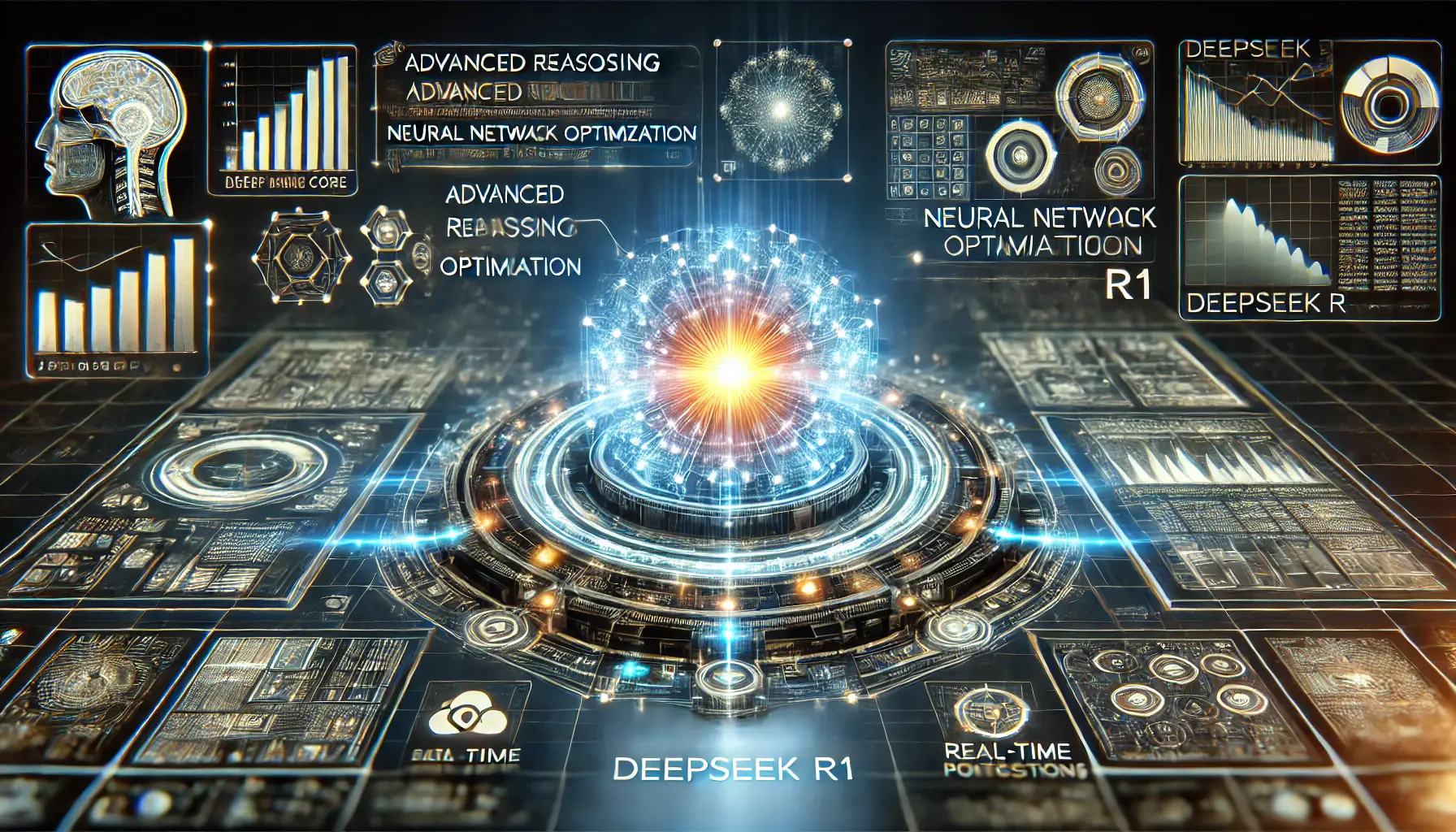
The cutting-edge innovations of DeepSeek R1, visualized through a futuristic AI dashboard with holographic data streams.
Key Features and Innovations of DeepSeek R1
DeepSeek R1 offers several standout features that set it apart from other AI models:
- Advanced Reasoning Capabilities: The model excels in tasks requiring logical inference and real-time decision-making, making it highly effective for complex problem-solving.
- Open-Source Accessibility: As an open-source AI model, DeepSeek R1 allows developers and organizations to access and build upon its architecture, fostering innovation and collaboration within the AI community.
- Cost-Effective Development: Developed at a fraction of the cost compared to other leading AI models, DeepSeek R1 proves that high-performance AI can be achieved without an exorbitant budget.
- Efficient Resource Utilization: The model’s development required fewer computational resources, emphasizing efficiency and sustainability in AI advancement.
These features make DeepSeek R1 a significant step forward in AI technology, offering a unique combination of performance, accessibility, and efficiency.
Its impact on the AI landscape is expected to inspire further innovations and developments in the field.
DeepSeek R1’s emergence marks a significant milestone in AI, offering a new level of efficiency and performance at a fraction of traditional costs.
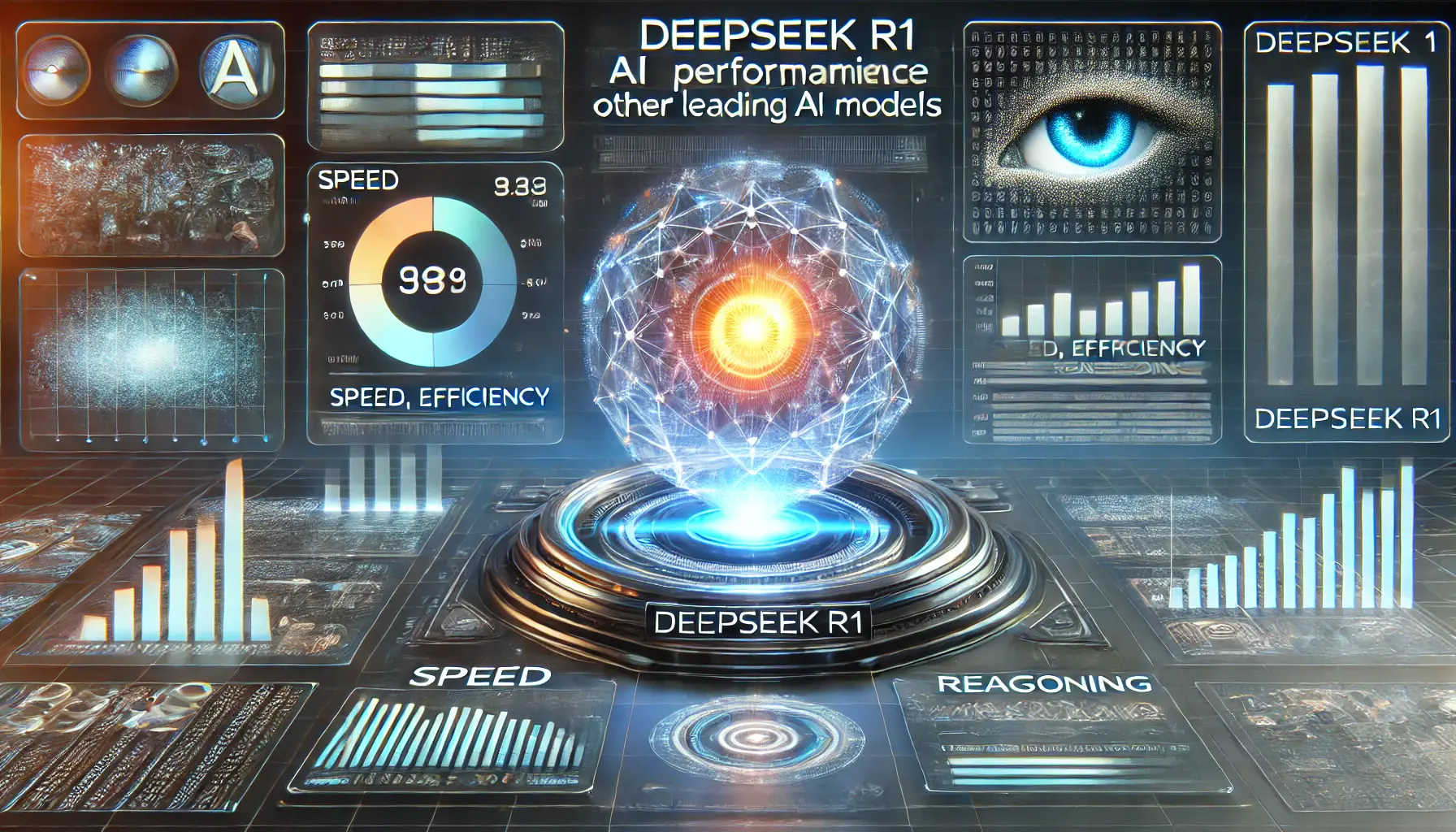
DeepSeek R1’s performance metrics compared to leading AI models in a high-tech benchmarking interface.
Performance Comparison: DeepSeek R1 vs. Leading AI Models
When evaluating artificial intelligence models, it’s essential to consider various performance metrics to determine their effectiveness across different tasks.
Let’s delve into how DeepSeek R1 measures up against other prominent AI models in key areas.
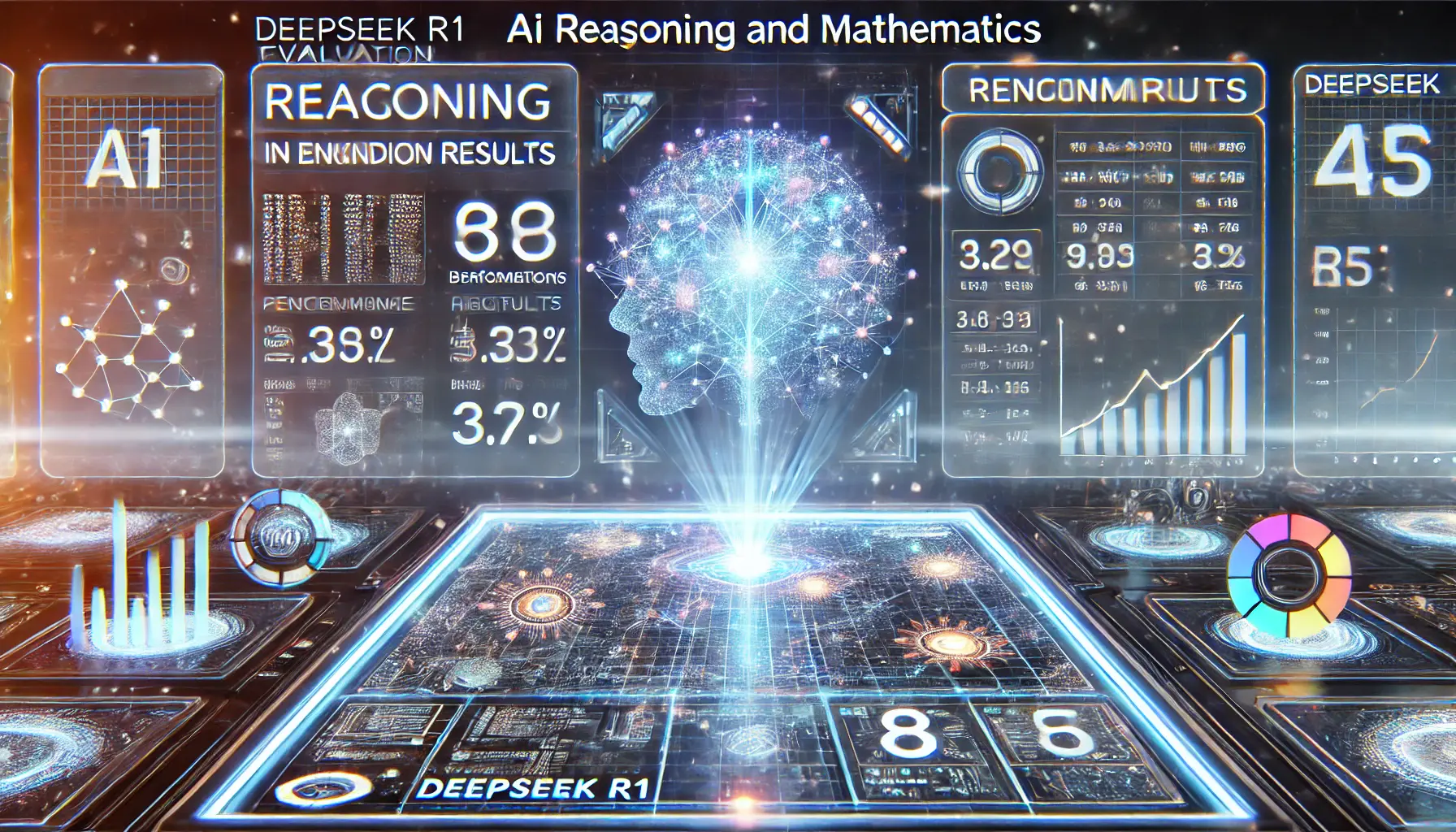
DeepSeek R1’s benchmark performance in reasoning and mathematics, visualized through a high-tech analytical dashboard.
Benchmark Results in Reasoning and Mathematics
DeepSeek R1 has shown remarkable capabilities in reasoning and mathematics.
In the AIMEAmerican Invitational Mathematics Examination, a competitive math contest assessing problem-solving skills. 2024 benchmark, which assesses complex multi-step mathematical reasoning, DeepSeek R1 outpaced OpenAI’s o1-1217 model, which scored 79.2%, with a score of 79.8%.
Additionally, DeepSeek R1 topped the MATH-500 benchmark with an impressive 97.3%, surpassing OpenAI’s o1-1217, which scored 96.4%.
These results highlight the model’s exceptional ability to solve mathematical problems.
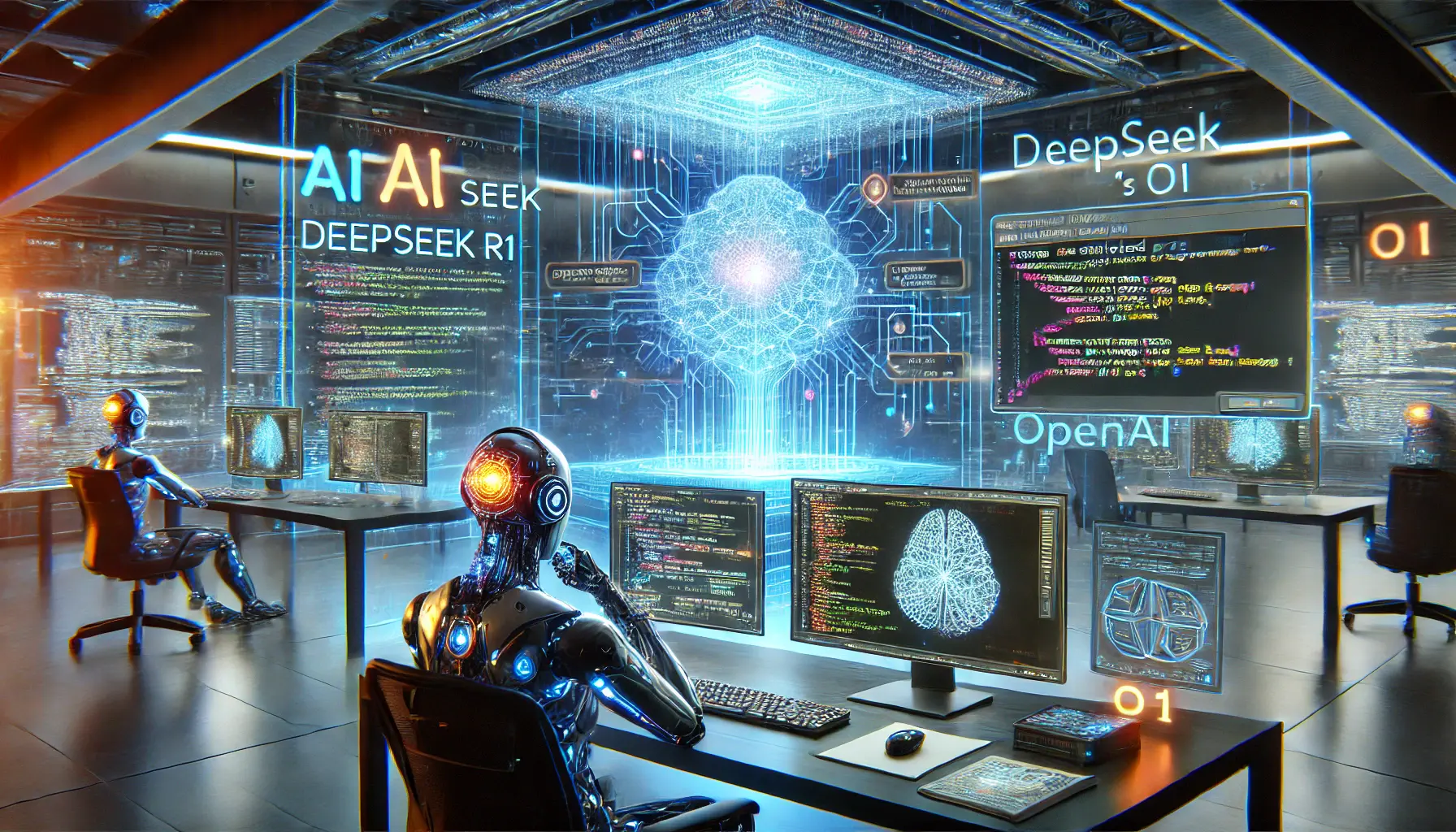
DeepSeek R1 and OpenAI’s o1 compared in a high-tech AI coding workspace, showcasing their algorithmic and programming capabilities.
Coding Capabilities: DeepSeek R1 vs. OpenAI’s o1
DeepSeek R1 also demonstrates strong coding and algorithmic reasoning abilities.
In the CodeforcesA competitive programming platform that hosts coding contests and challenges. benchmark, which measures a model’s coding proficiency against human participants, OpenAI’s o1-1217 leads with 96.6%, while DeepSeek R1 scores a competitive 96.3%.
This minor difference suggests that DeepSeek R1 is nearly on par with OpenAI’s model for coding tasks.
Furthermore, in the SWE-bench Verified benchmark, which assesses reasoning in software engineering tasks, DeepSeek R1 performs strongly with a score of 49.2%, slightly ahead of OpenAI’s o1-1217 at 48.9%.
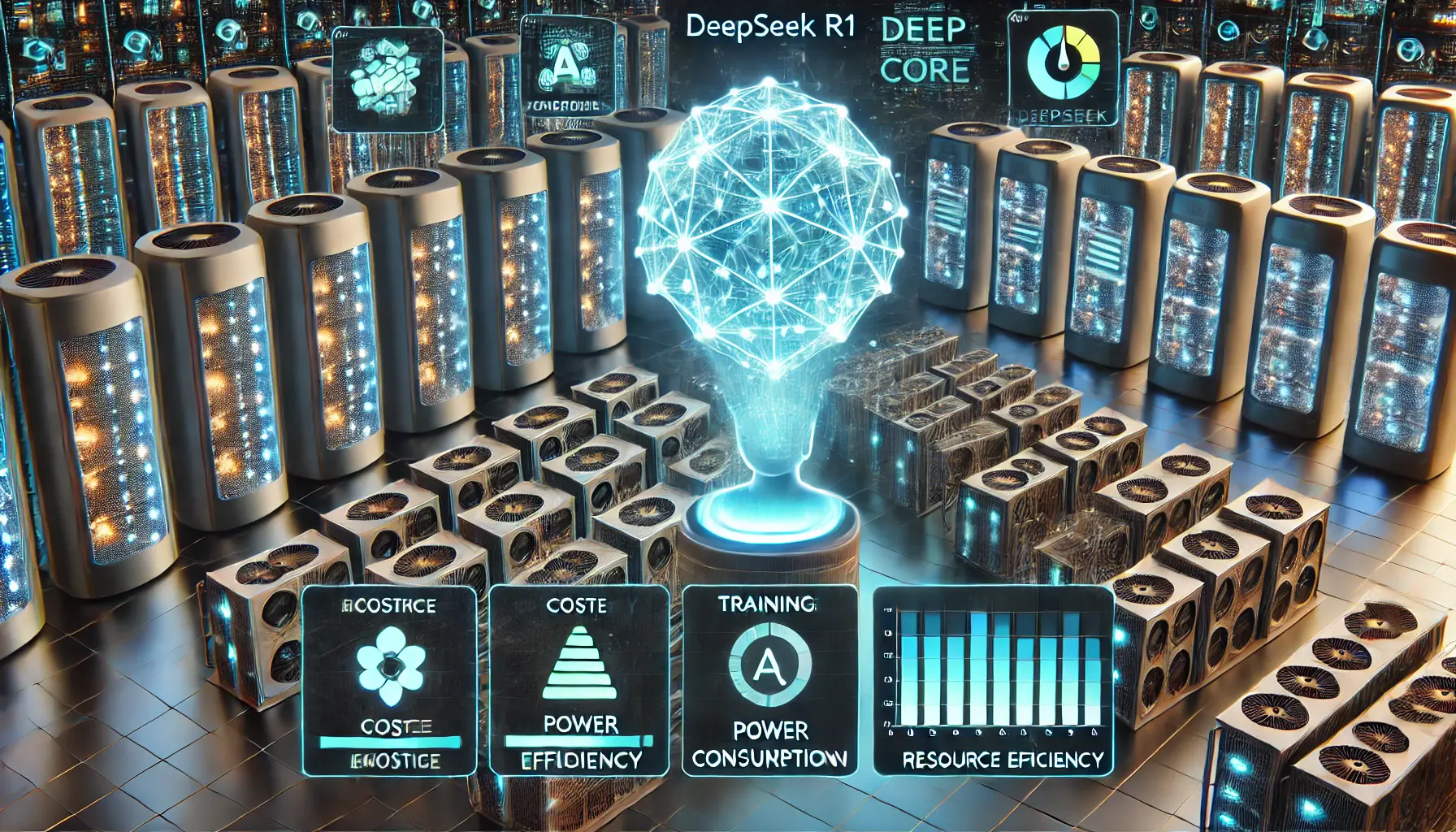
DeepSeek R1’s optimized resource usage visualized in an advanced AI data center, highlighting efficiency and cost-effectiveness.
Resource Efficiency and Training Costs Across Models
One of the standout aspects of DeepSeek R1 is its cost-effective development.
The model was built using just 2,048 Nvidia H800 GPUs at a cost of $5.6 million, showcasing a resource-efficient approach that contrasts sharply with the billion-dollar budgets of Western competitors.
This efficiency not only makes high-performance AI more accessible but also challenges the notion that cutting-edge AI development requires massive financial investments.
In summary, while DeepSeek R1 delivers state-of-the-art performance in reasoning, mathematics, and coding, it also establishes a new standard in resource efficiency and cost-effective AI development.
Its performance rivals that of top-tier models, including OpenAI’s o1, solidifying its position as a leading force in the AI landscape.
Benchmark results indicate that DeepSeek R1 competes closely with industry-leading models in reasoning, mathematics, and coding efficiency.
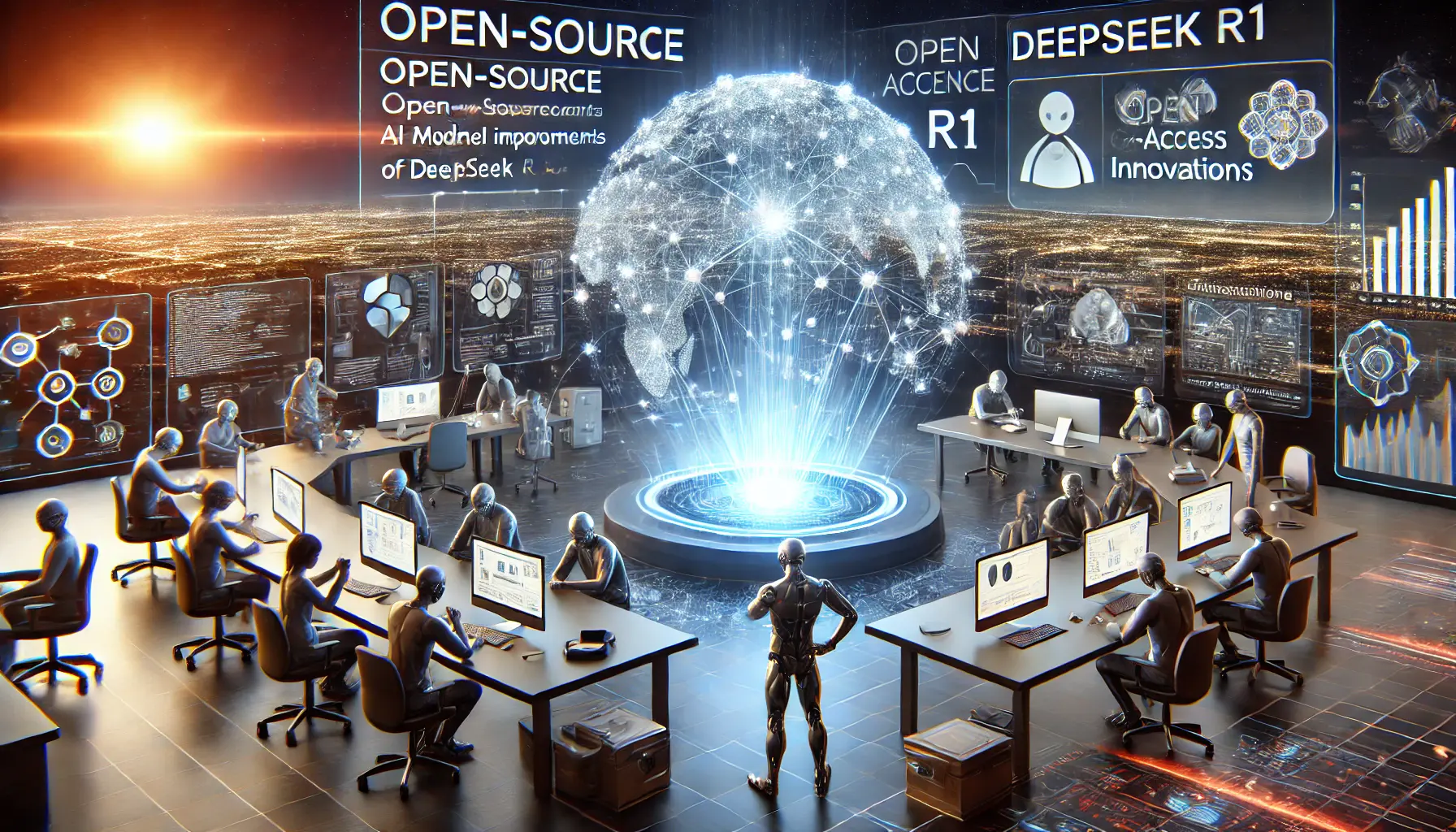
DeepSeek R1’s open-source innovation fosters global collaboration and AI advancements.
Open-Source Impact: DeepSeek R1’s Influence on the AI Community
The emergence of DeepSeek R1 has significantly impacted the AI community, particularly due to its open-source nature.
This approach has fostered widespread adoption and adaptation among developers and organizations, while also prompting a comparative analysis between open-source and proprietary AI models.
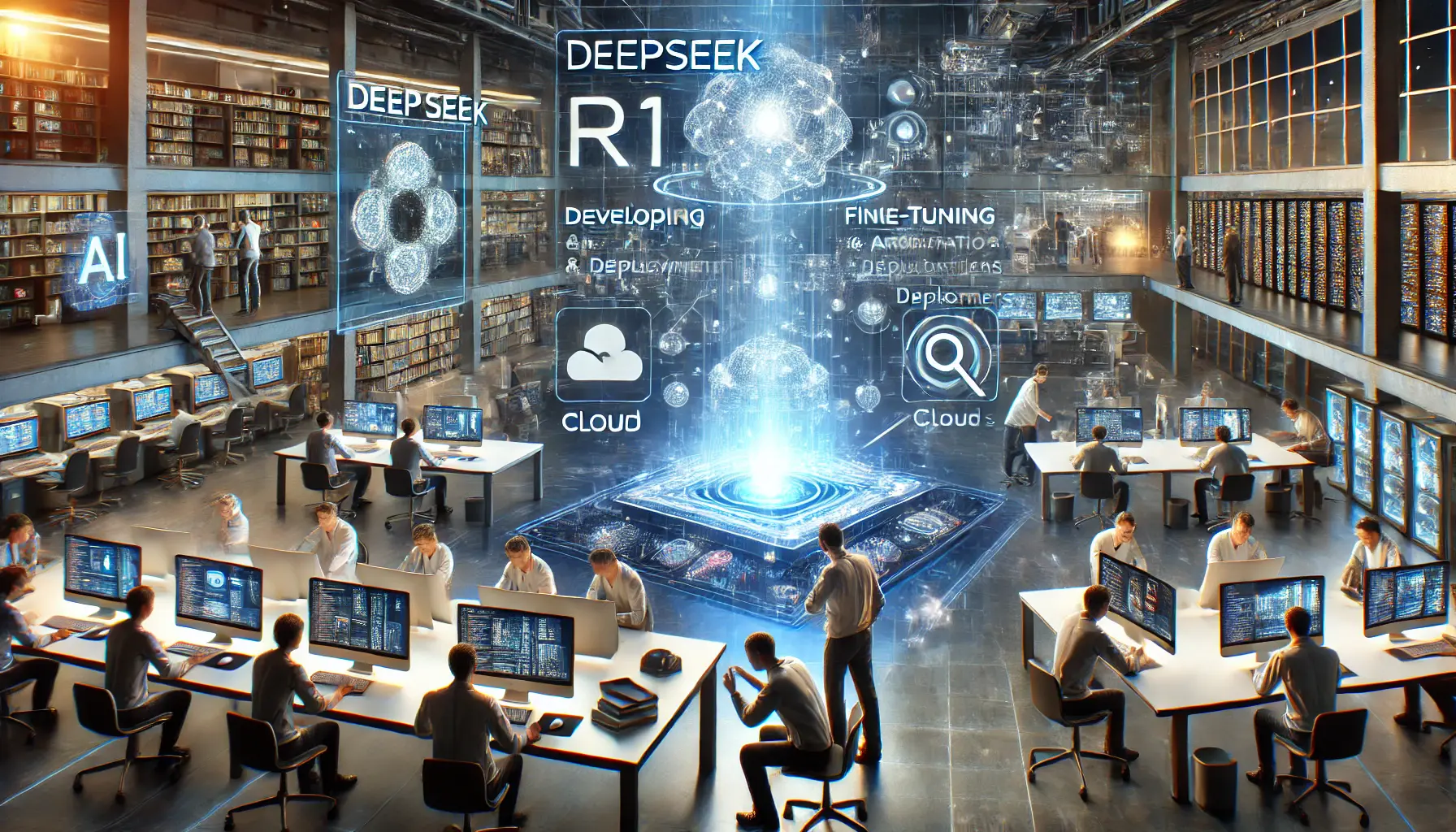
Developers and organizations collaborate to integrate DeepSeek R1, enhancing AI-driven solutions across industries.
Adoption and Adaptation by Developers and Organizations
Since its launch, DeepSeek R1 has been widely adopted by various developers and organizations.
Its open-source model weights can be deployed on local or cloud GPUGraphics Processing Unit, a specialized electronic circuit designed to accelerate computing tasks. infrastructures, allowing full control over security, data, and operations.
This accessibility has led to several advantages:
- Rapid Integration: Developers can seamlessly integrate DeepSeek R1 into existing systems, enhancing functionalities without incurring significant costs.
- Customization: Organizations have the flexibility to fine-tune the model to meet specific needs, leading to innovative applications across various industries.
- Community Collaboration: The open-source nature encourages collaboration, with contributors worldwide improving and expanding upon the original model.
These factors have contributed to a vibrant ecosystem around DeepSeek R1, accelerating advancements in AI applications.
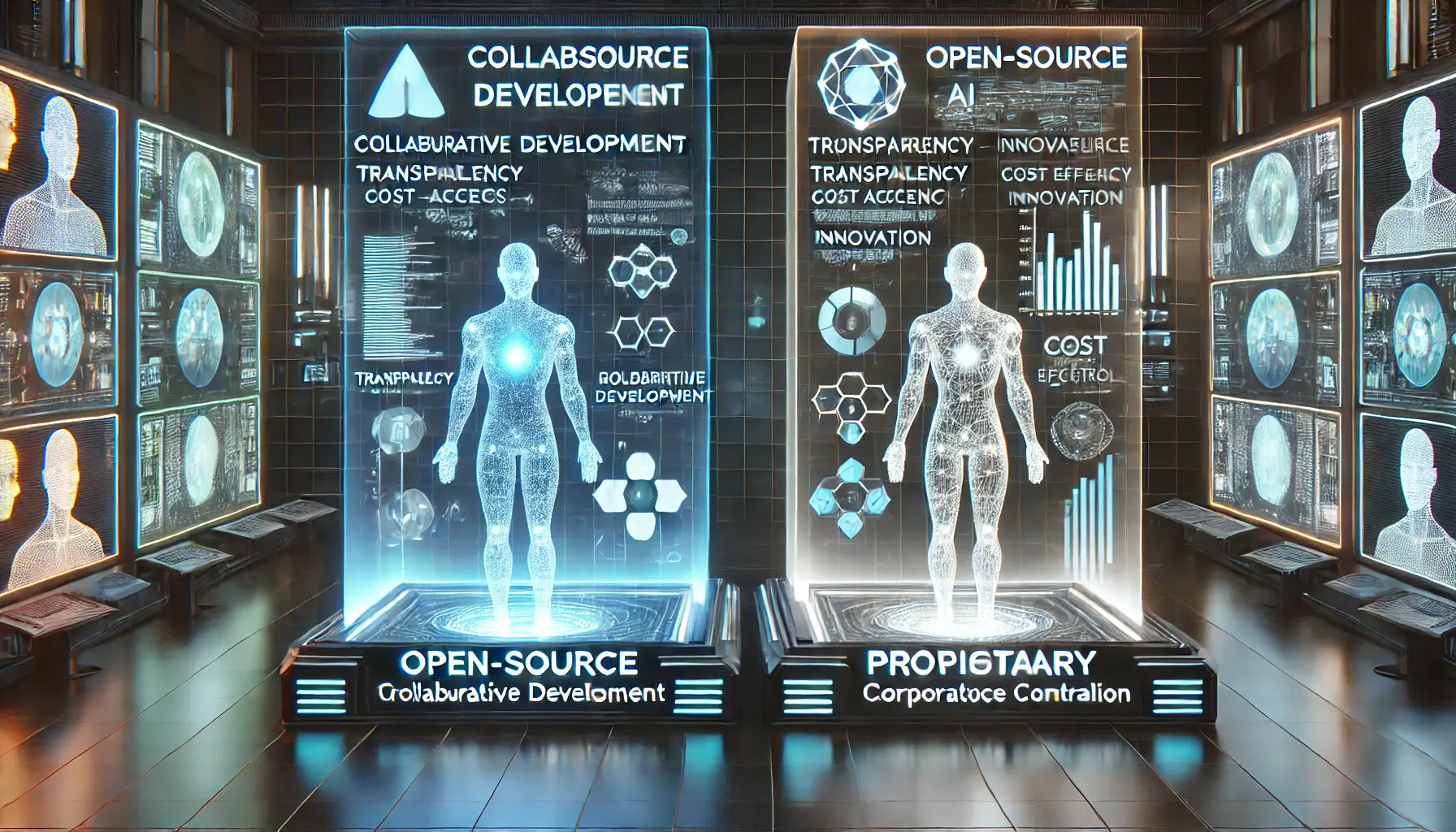
A visual representation comparing open-source AI collaboration with proprietary AI restrictions.
Comparative Analysis of Open-Source and Proprietary AI Models
The rise of DeepSeek R1 has reignited discussions around open-source versus proprietary AI models.
Key considerations include:
- Transparency: Open-source models like DeepSeek R1 offer greater transparency, allowing users to understand and trust the inner workings of the model.
- Cost Efficiency: Developing and utilizing open-source models is often more cost-effective, reducing dependency on expensive proprietary solutions.
- Security: Open-source models can be deployed on local or cloud GPU infrastructure, ensuring full control over security, data, and operations.
- Innovation: The collaborative nature of open-source fosters continuous improvement, as a global community contributes to the model’s evolution.
On the other hand, proprietary models often provide polished, user-friendly experiences but come with limitations such as restricted access, high costs, and limited customization options.
The success of DeepSeek R1 exemplifies how open-source AI can rival, and in some cases outperform, proprietary models, potentially reshaping the future landscape of AI development.
The open-source nature of DeepSeek R1 fosters innovation, allowing global developers to modify and enhance the model for diverse applications.
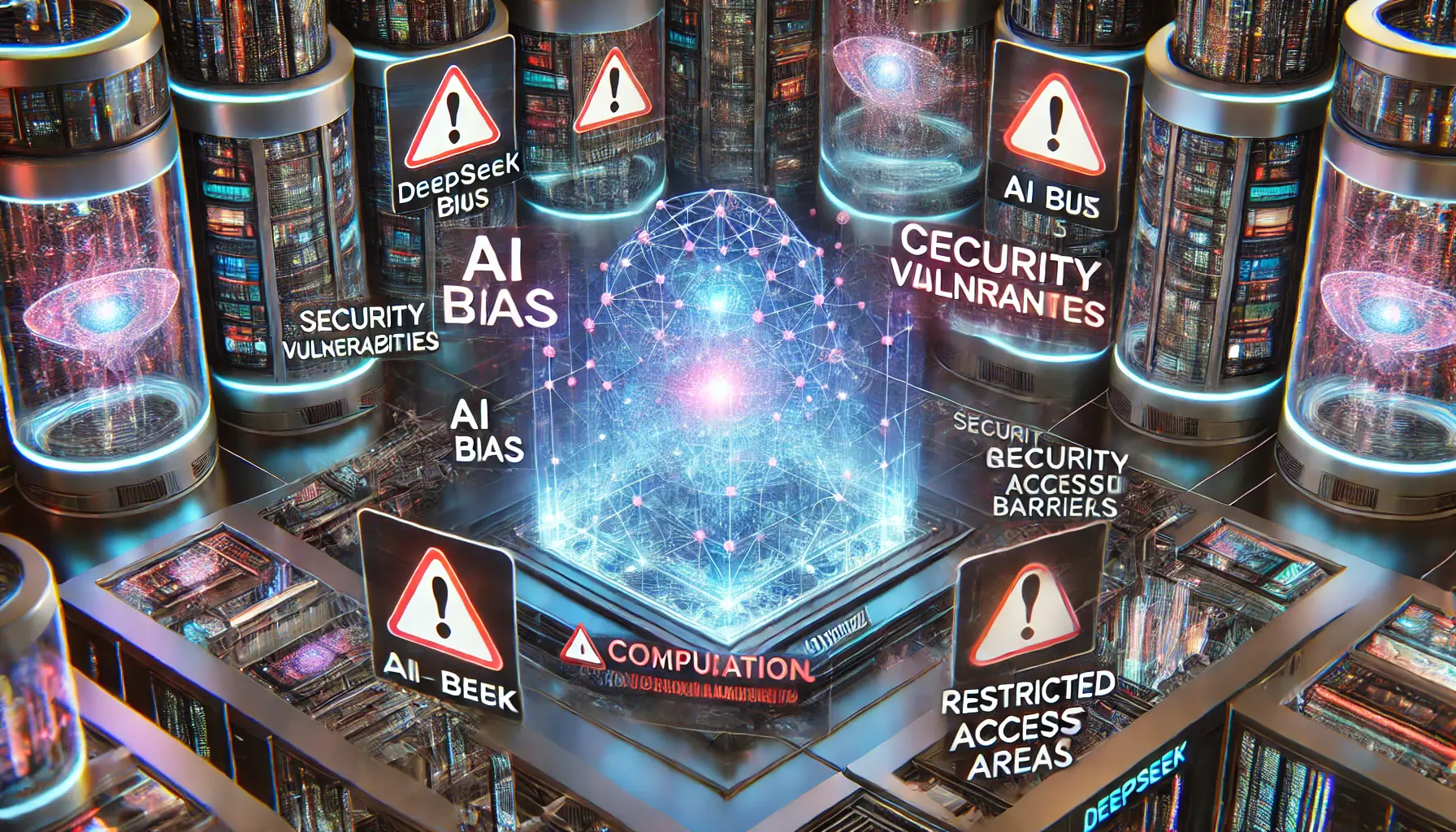
DeepSeek R1 encounters AI biases, computational constraints, and censorship barriers in its development.
Challenges and Limitations of DeepSeek R1
While DeepSeek R1 has garnered attention for its advancements in artificial intelligence, it is not without its challenges and limitations.
Understanding these aspects is crucial for developers and organizations considering its deployment.

DeepSeek R1’s AI system enforces content restrictions, blocking certain queries with digital security measures.
Censorship and Content Restrictions in DeepSeek R1
One significant concern with DeepSeek R1 is its implementation of censorship mechanisms, particularly on topics deemed sensitive by the Chinese government.
For instance, the model avoids discussions related to the 1989 Tiananmen Square incident and the political status of Taiwan.
When prompted on these subjects, it often responds with messages like, “Sorry, that’s beyond my current scope.
Let’s talk about something else.” This built-in censorship can limit the model’s applicability for users seeking open and unbiased information.
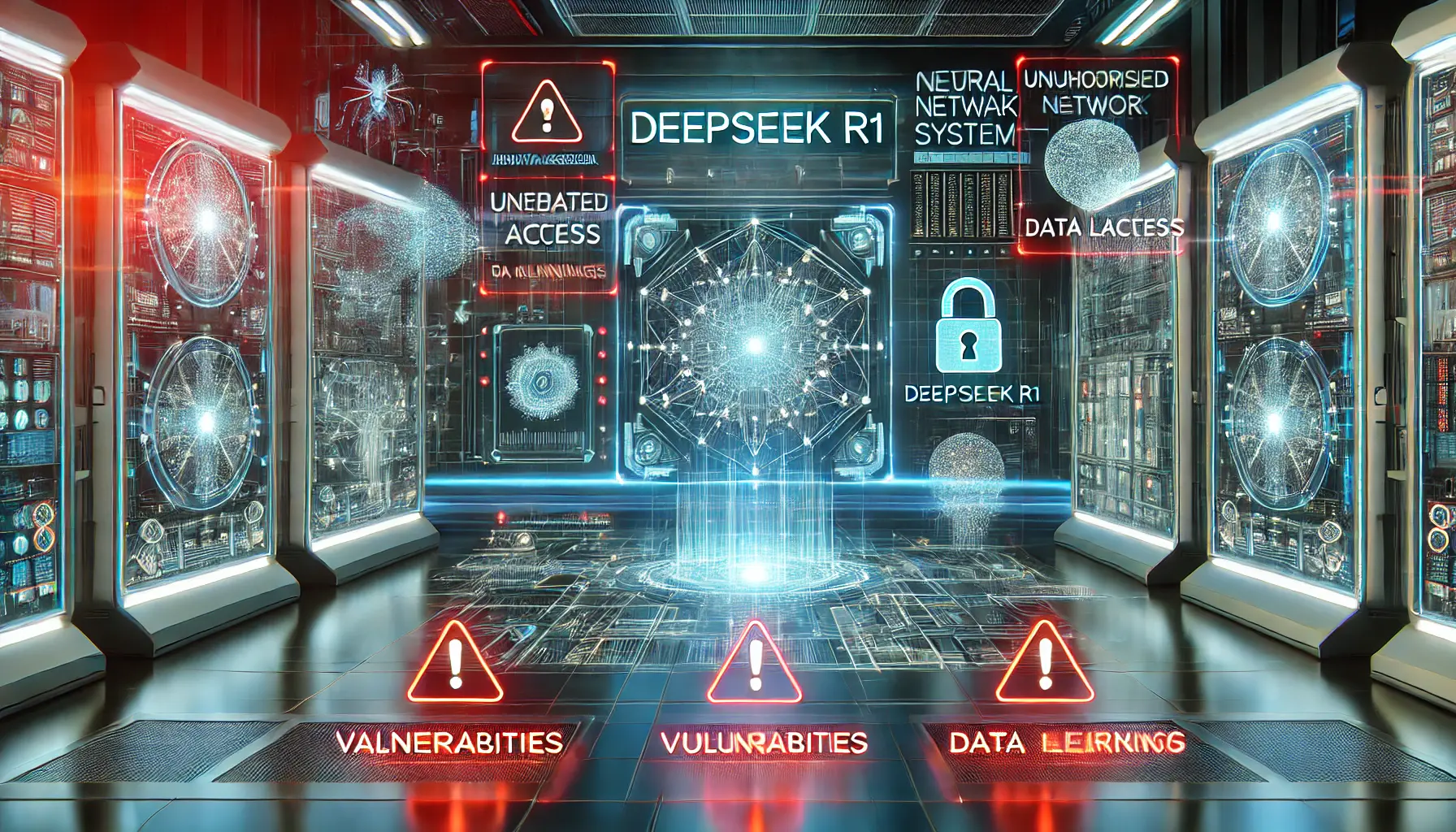
DeepSeek R1’s AI system faces security threats, including data breaches and AI exploitation risks.
Security Vulnerabilities and Safety Concerns
Security vulnerability tests have identified that DeepSeek R1 may be susceptible to several risks, including:
- Jailbreak Techniques: Methods that bypass the model’s safety features, forcing it to produce harmful, offensive, or unintended content.
- Prompt Injections: Malicious inputs designed to manipulate the model into generating insecure code or leaking sensitive information.
- Glitch Tokens: Exploiting tokenization errors that can disrupt the model’s responses, leading to unpredictable behavior.
These vulnerabilities highlight the need for rigorous evaluation and caution when deploying DeepSeek R1 in sensitive or security-critical applications.

DeepSeek R1’s AI ethics challenges, highlighting algorithmic biases, fairness analysis, and decision transparency.
Biases and Ethical Considerations
Like many AI models, DeepSeek R1 exhibits inherent biases stemming from its training data and reinforcement learningA machine learning technique where an AI model learns by receiving rewards for correct decisions. processes.
These biases can manifest in various ways, such as:
- Reinforcement Learning Limitations: The model may optimize for predefined reward systems, producing outputs that seem neutral but still retain subtle biases.
- Generalization Failures: The model struggles to handle nuanced or previously unseen scenarios, leading to unreliable responses in real-world applications.
Addressing these ethical considerations is essential to ensure the responsible use of DeepSeek R1.
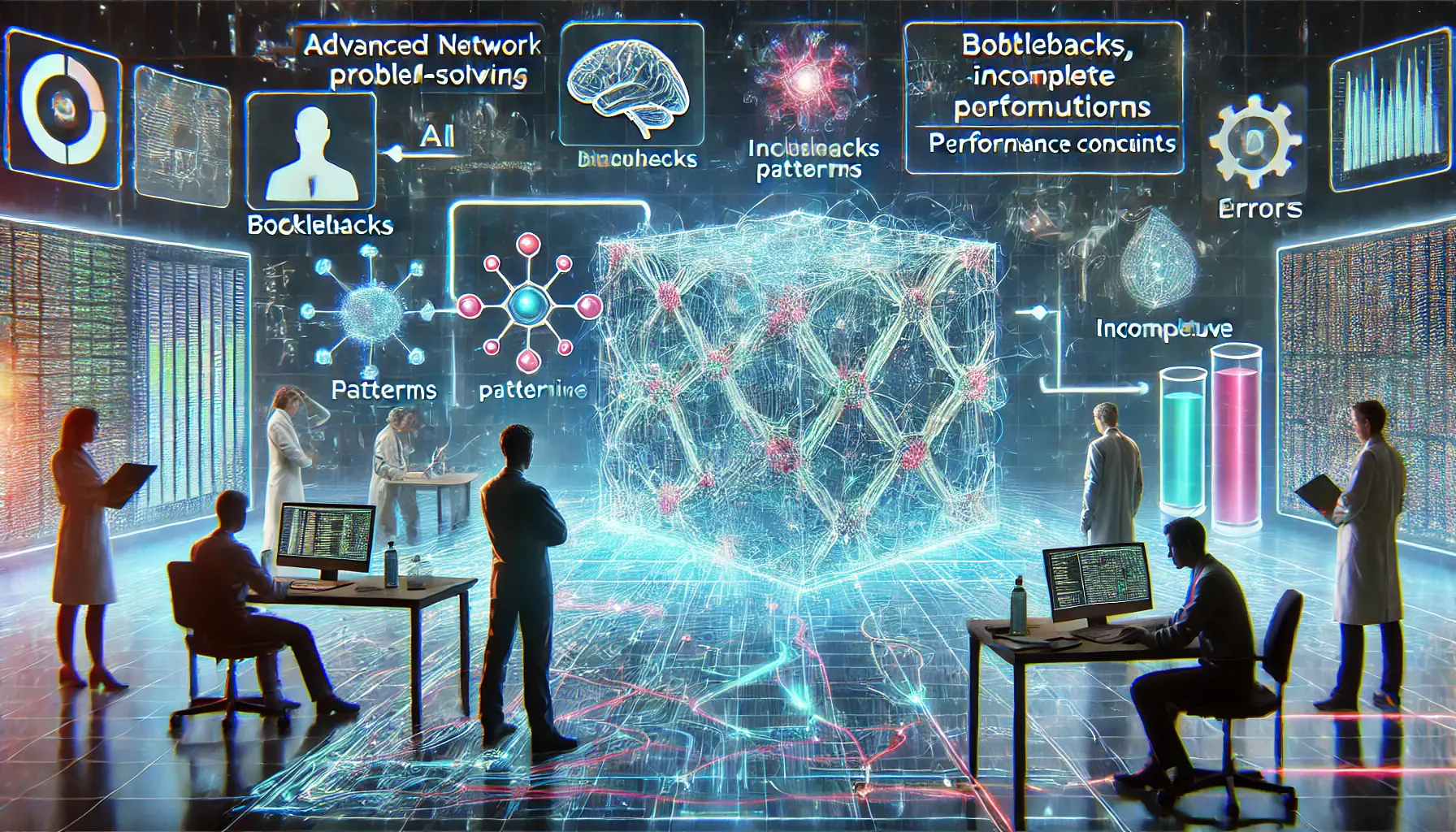
DeepSeek R1 faces challenges in processing intricate tasks, highlighting its performance limitations.
Performance Limitations in Complex Tasks
Despite its strengths, DeepSeek R1 experiences difficulties with certain complex tasks.
For instance, in coding and algorithmic reasoning, the model has been observed to overthink simple problems that other models solve more efficiently.
Additionally, while it performs well in basic mathematical reasoning, it struggles with multi-step parameter definitions and constraints, leading to errors in more complex mathematical problems.
Understanding these performance limitations is important for developers to set realistic expectations and implement necessary mitigations when deploying DeepSeek R1.
In summary, DeepSeek R1 represents a significant advancement in AI.
However, acknowledging and addressing its challenges through ongoing research, rigorous testing, and ethical considerations will be essential for its responsible and effective deployment.
Despite its strengths, DeepSeek R1 has built-in censorship and security vulnerabilities, requiring careful consideration for sensitive applications.

DeepSeek R1’s future developments in AI reasoning, computational efficiency, and multilingual support.
Future Prospects and Developments for DeepSeek R1
As we look ahead, the trajectory of DeepSeek R1 in the artificial intelligence landscape is poised for significant evolution.
Its recent advancements have already made a substantial impact, and the future holds promising developments.
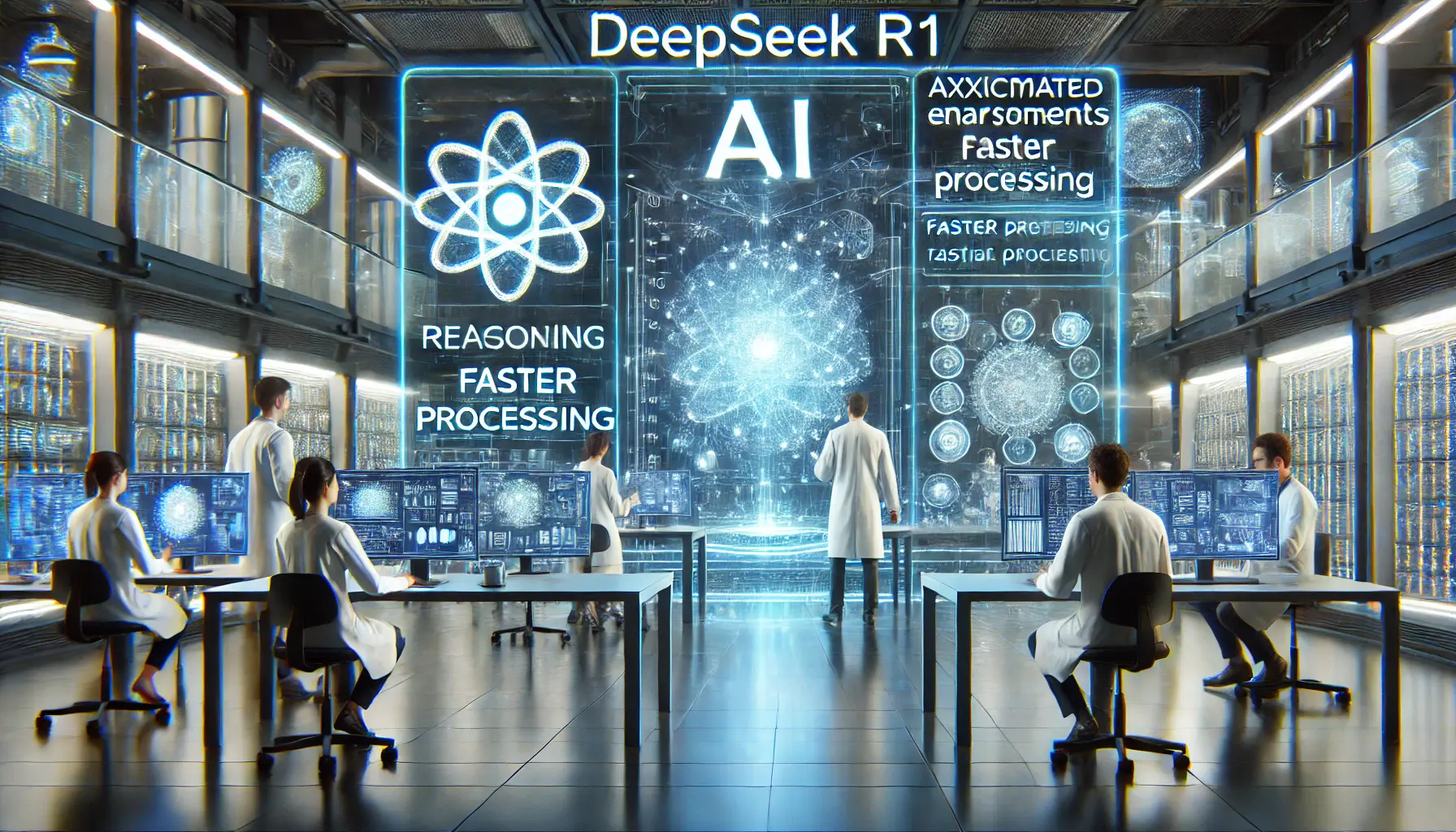
DeepSeek R1’s upcoming innovations in AI reasoning, processing speed, and multilingual capabilities.
Anticipated Enhancements and Innovations
Building upon its current capabilities, DeepSeek R1 is expected to undergo several enhancements:
- Increased Computational Efficiency: Future updates will focus on optimizing processing power, enabling faster execution of complex AI tasks.
- Expanded Multilingual Support: Advancements in language comprehension will allow DeepSeek R1 to provide more accurate and diverse linguistic interactions.
- Enhanced Logical Reasoning: Expected improvements in problem-solving and inference capabilities will further strengthen its ability to handle complex challenges.
These developments are geared toward maintaining DeepSeek R1’s competitive edge and addressing its current limitations.

DeepSeek R1’s transformative impact on business, research, and AI technology worldwide.
Potential Impact on the AI Industry
The advancements in DeepSeek R1 are likely to influence the broader AI industry in several ways:
- Cost-Effective AI Solutions: Its efficient development model may redefine cost management in AI projects, challenging conventional financial models.
- Open-Source Collaboration: By fostering an open-source approach, DeepSeek R1 encourages global collaboration, driving faster AI innovations.
- Competitive Market Dynamics: The rise of DeepSeek R1 could intensify competition, prompting leading AI developers to innovate more aggressively.
These potential impacts highlight the transformative role that DeepSeek R1 may play in shaping the future of artificial intelligence.
The future of DeepSeek R1 appears bright, with anticipated improvements that could redefine industry standards and influence AI development worldwide.
With improvements in multilingual support and computational efficiency, DeepSeek R1 is set to redefine AI accessibility and innovation.

DeepSeek R1’s continuous evolution, from past developments to future AI innovations.
The Evolution and Future of DeepSeek R1
DeepSeek R1 has emerged as a powerful force in artificial intelligence, demonstrating its ability to compete with leading AI models while maintaining a cost-effective and efficient development approach.
Its open-source nature has fueled widespread adoption and innovation, but it also comes with challenges that must be addressed for long-term success.
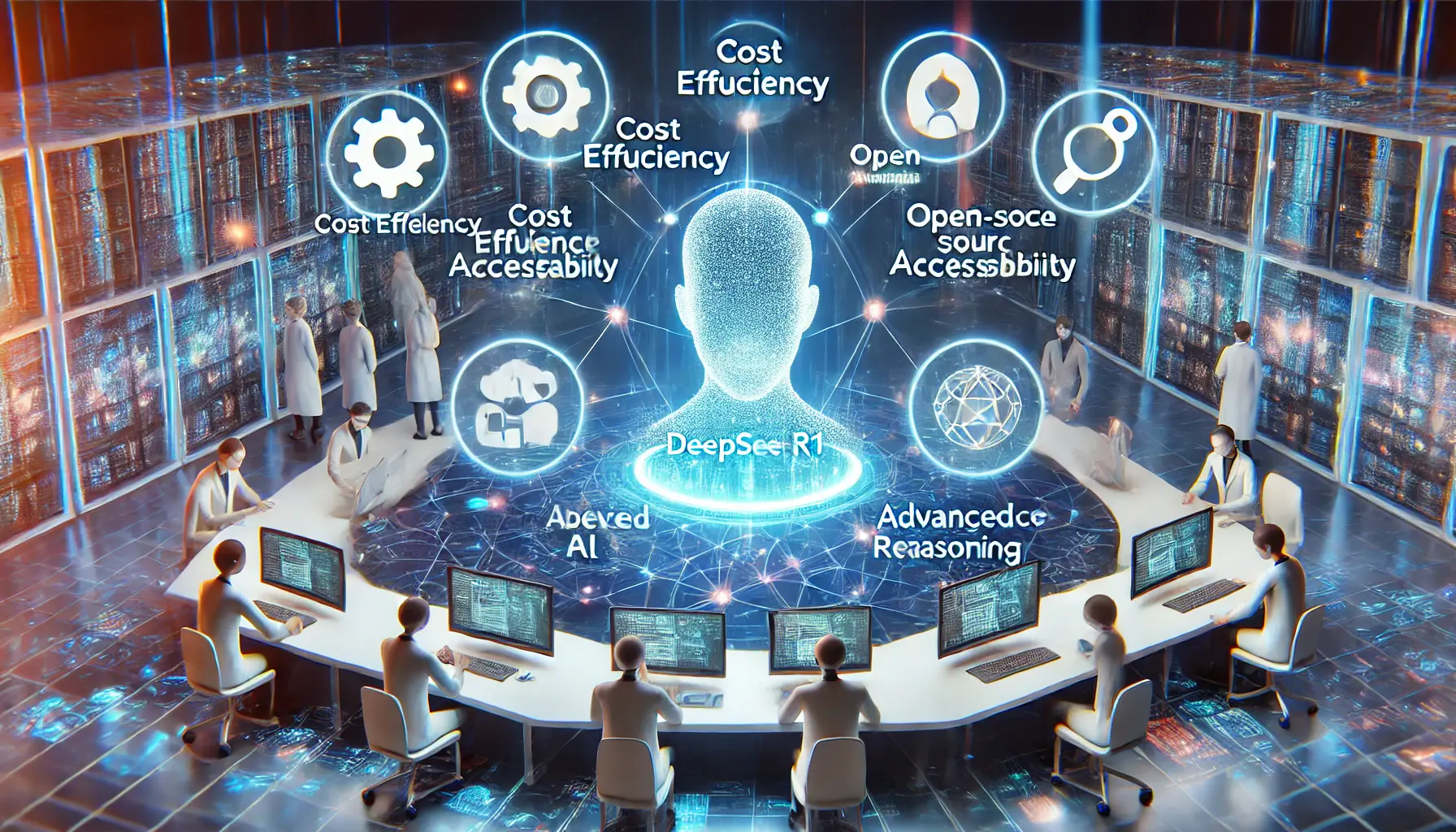
The key innovations and accomplishments from DeepSeek R1’s development process, visualized in a high-tech AI lab.
Key Takeaways from DeepSeek R1’s Development
Throughout this review, we have discussed DeepSeek R1 from its emergence to its potential future.
Here are some of the key takeaways:
- Competitive Performance: DeepSeek R1 has demonstrated strong capabilities in reasoning, mathematics, and coding, matching or outperforming well-established AI models in many cases.
- Cost-Effective AI Development: Unlike many proprietary AI models, DeepSeek R1 was developed with a fraction of the budget, proving that efficiency does not have to come at the expense of quality.
- Open-Source Collaboration: By embracing open-source accessibility, DeepSeek R1 allows global developers to customize and integrate it into various applications, fostering innovation and wider adoption.
- Challenges and Limitations: Issues such as content censorship, security vulnerabilities, and biases highlight the need for ongoing refinement to ensure ethical and reliable AI performance.

DeepSeek R1 reshaping the AI landscape through interconnected global systems and technological advancements.
How DeepSeek R1 is Shaping the AI Landscape
DeepSeek R1 is more than just a technological breakthrough; it represents a shift in the AI landscape.
It has proven that open-source AI models can compete with proprietary alternatives, offering transparency, flexibility, and cost efficiency.
This makes it a compelling alternative to the closed-source models that dominate the market.
Furthermore, its ability to function on relatively low computational resources challenges the notion that AI innovation requires billion-dollar investments.
This could inspire a new wave of AI development that prioritizes efficiency over excessive scaling.
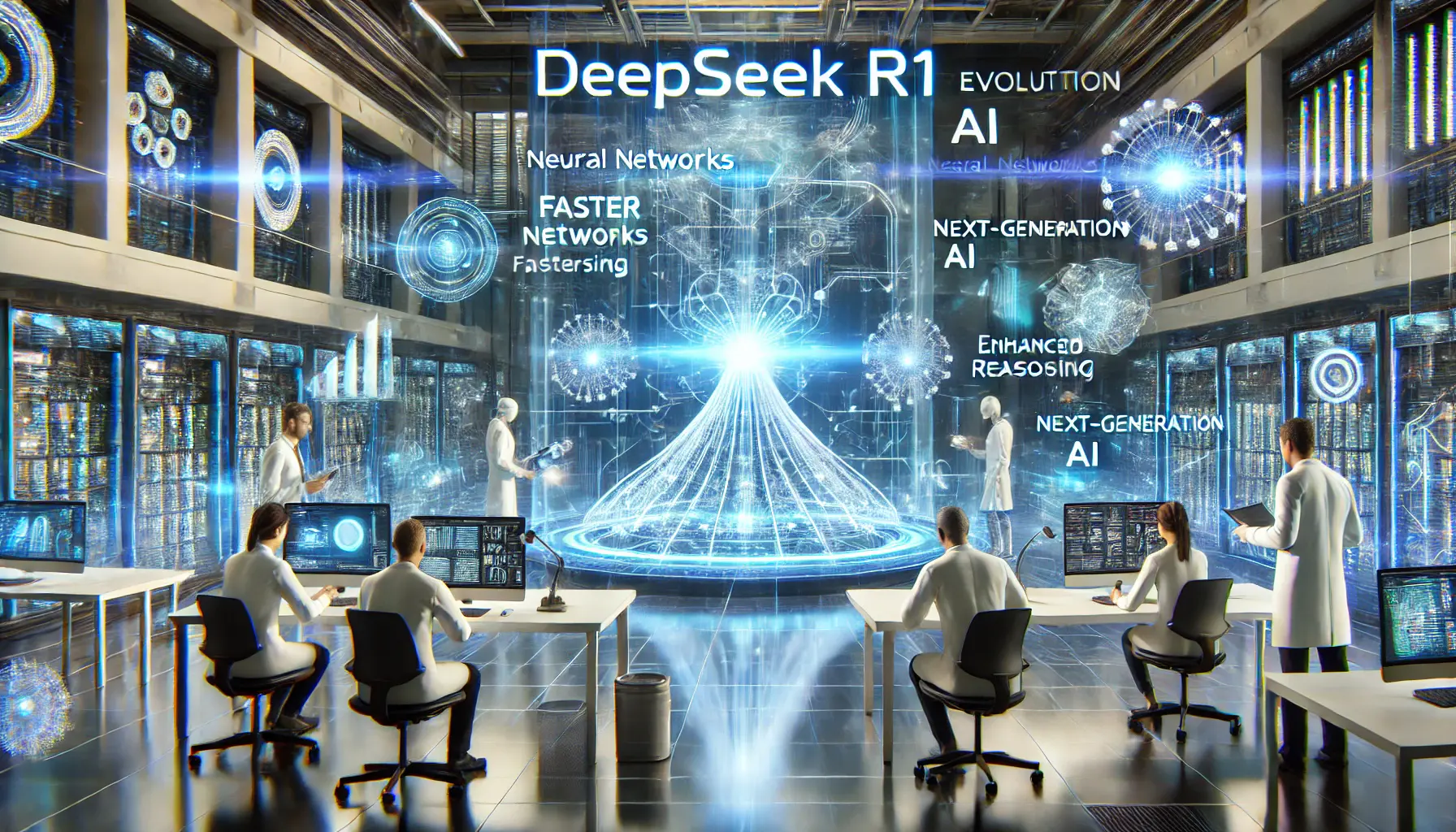
The future of DeepSeek R1, visualized through advanced neural networks and next-gen AI features in a high-tech lab.
What’s Next for DeepSeek R1
DeepSeek R1 will continue to evolve, with several key developments expected in the future:
- Improved Reasoning and Problem-Solving: Future iterations are likely to overcome current performance limitations, particularly in handling complex logical tasks and multi-step problem-solving.
- Multilingual Expansion: Enhanced natural language processing (NLP) capabilities will enable DeepSeek R1 to serve a broader global audience with greater accuracy and efficiency.
- Stronger Security Measures: Addressing vulnerabilities such as prompt injections and jailbreak techniques will be crucial to maintaining the model’s reliability and trustworthiness.
- Ethical AI Development: A continued focus on reducing biases and ensuring content neutrality will be essential for broader adoption across different regions and industries.
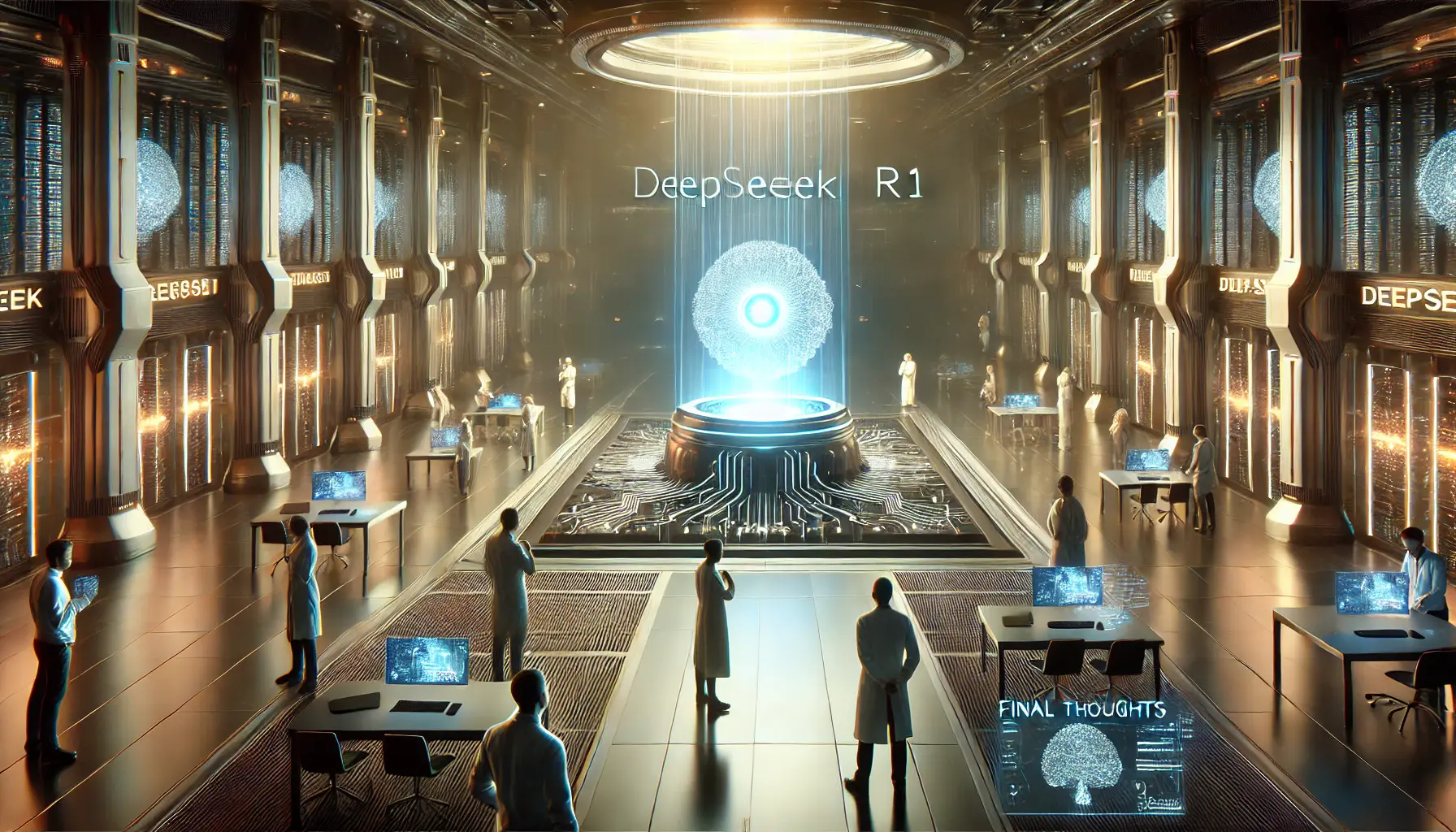
DeepSeek R1’s journey reflected in a high-tech AI research facility, symbolizing its influence and future potential.
Final Thoughts
The impact of DeepSeek R1 is undeniable.
It has challenged traditional AI development methodologies by proving that open-source models can be competitive, innovative, and efficient.
However, its future success will depend on how well it addresses its limitations while continuing to push the boundaries of artificial intelligence.
With continuous improvements and strong community support, DeepSeek R1 has the potential to define the future of AI models, driving innovation, accessibility, and ethical considerations in artificial intelligence development.
DeepSeek R1 challenges conventional AI development methods by proving that cost-effective, open-source models can rival proprietary alternatives.
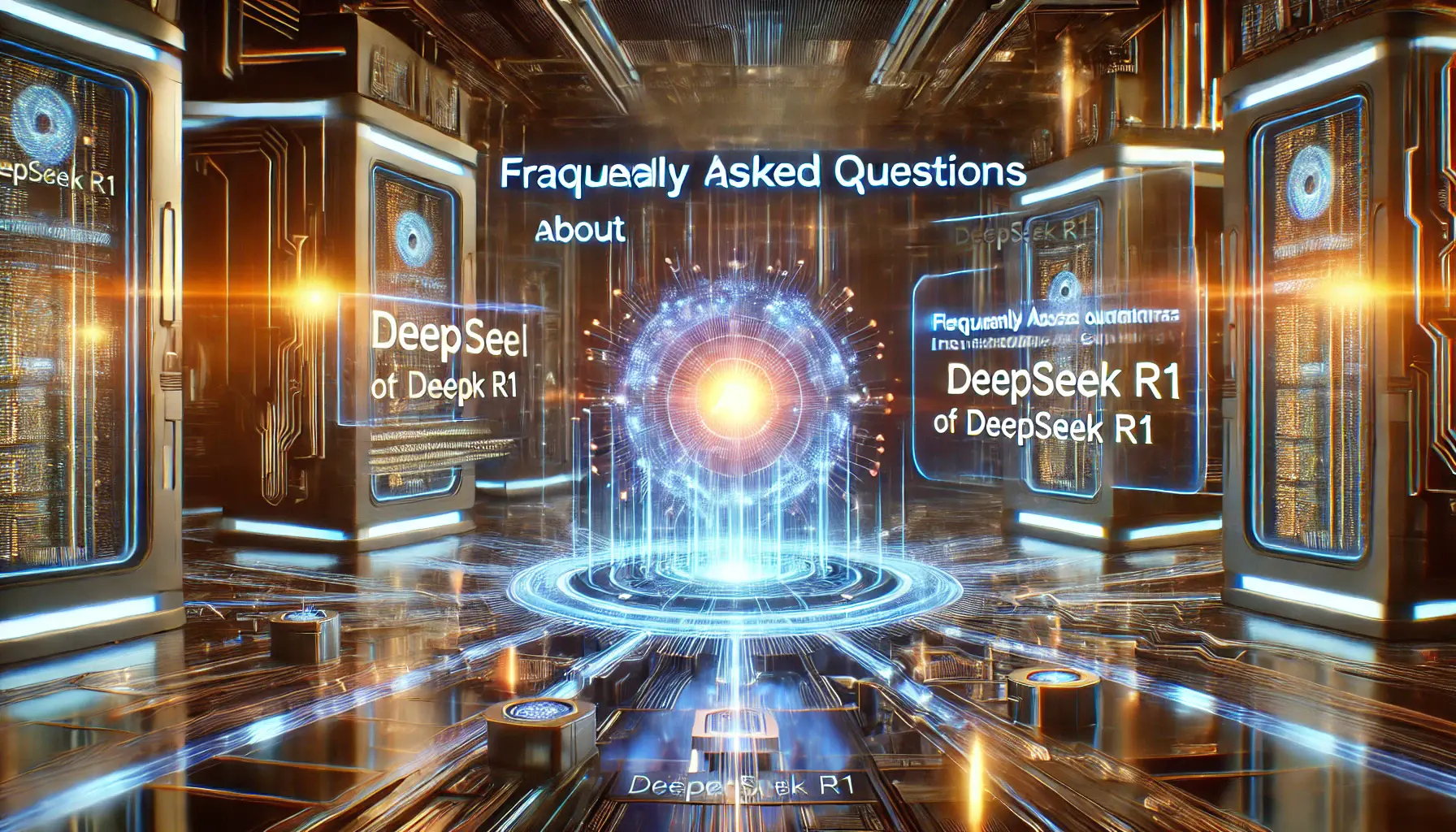
Exploring DeepSeek R1’s features through an advanced AI interface, visualizing frequently asked questions.
DeepSeek R1: Frequently Asked Questions
DeepSeek R1 is an open-source AI model developed by the Chinese AI company DeepSeek.
It specializes in reasoning, mathematics, and coding tasks, making it a powerful alternative to existing AI models.
DeepSeek R1 matches or surpasses leading AI models in reasoning and mathematics.
It offers competitive performance while being more cost-efficient in its development and implementation.
Yes, DeepSeek R1 is fully open-source, with its model weights available under the MIT licenseA permissive open-source license that allows free use, modification, and distribution of software..
This allows developers to access, modify, and integrate it into various applications without restrictions.
DeepSeek R1 excels in logical inference, mathematical reasoning, and real-time problem-solving.
Its cost-efficient development model and open-source nature make it accessible to a wide range of users.
Despite its strengths, DeepSeek R1 has built-in content restrictions on sensitive topics.
It may also exhibit biases due to its training data, requiring careful monitoring in critical applications.
Developers can integrate DeepSeek R1 via its API or use its open-source model weights to customize and deploy it in various applications, from AI research to enterprise solutions.
Like other AI models, DeepSeek R1 is vulnerable to potential security risks, including prompt injections and jailbreakA method to bypass restrictions in AI models, enabling unauthorized responses or actions. techniques.
Developers must implement safeguards when deploying it in sensitive environments.
DeepSeek R1 has built-in censorship that prevents discussions on politically sensitive subjects.
When prompted, it typically redirects conversations to neutral or unrelated topics.
Future developments for DeepSeek R1 focus on improving computational efficiency, expanding multilingual support, and enhancing its reasoning capabilities to compete with proprietary AI models.





